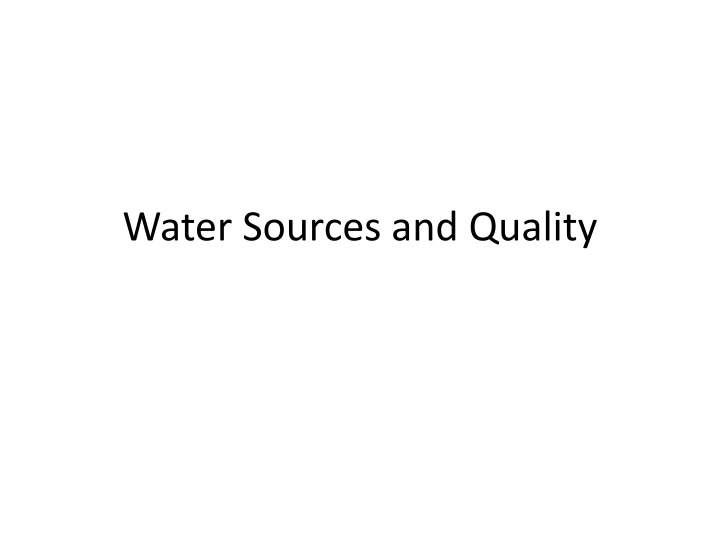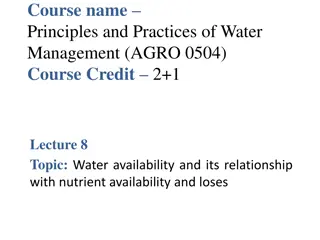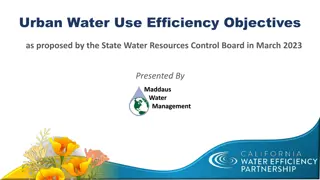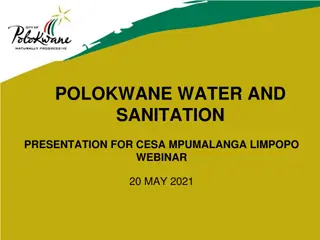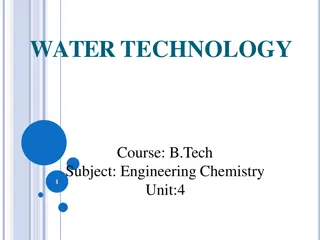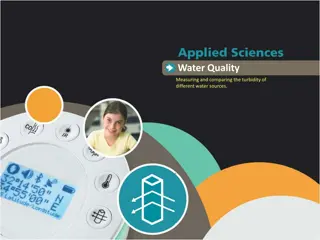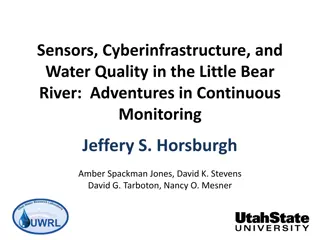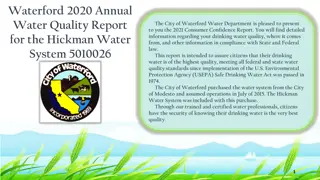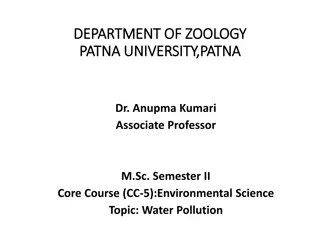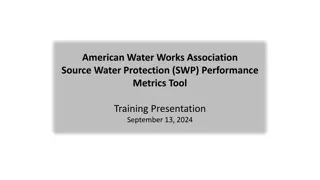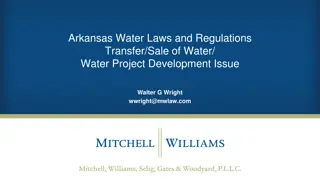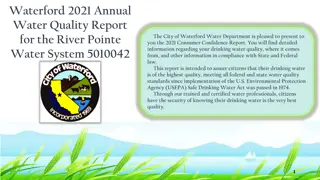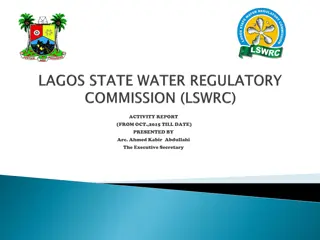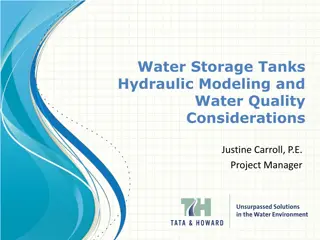Water Sources and Quality Overview
Groundwater from deep/shallow wells, fresh surface water from rivers/lakes, seawater, and reclaimed wastewater are discussed in terms of quality, characteristics, and standards. The content covers the differences between the sources, their susceptibility to pollution, treatment requirements, and the significance of water quality standards and criteria. Additionally, the description delves into the challenges of restoring polluted groundwater, the necessity of desalination for seawater, and the importance of quality criteria for treated wastewater disposal and reuse.
Download Presentation

Please find below an Image/Link to download the presentation.
The content on the website is provided AS IS for your information and personal use only. It may not be sold, licensed, or shared on other websites without obtaining consent from the author.If you encounter any issues during the download, it is possible that the publisher has removed the file from their server.
You are allowed to download the files provided on this website for personal or commercial use, subject to the condition that they are used lawfully. All files are the property of their respective owners.
The content on the website is provided AS IS for your information and personal use only. It may not be sold, licensed, or shared on other websites without obtaining consent from the author.
E N D
Presentation Transcript
Water Sources and Main Characteristics Groundwater (deep/shallow wells) Not exposed to pollution but once polluted, restoration is difficult, expensive, and long term. Free of pathogens and turbidity (filtration action of soil). May contain gases e.g. CO2, H2S (from bacterial decomposition of organic matter in soil or by-product of reduction of sulfur from mineral deposits). May contain Ca++, Mg++(hard water), fluoride, iron and manganese (Fe and Mn). May contain large quantities of dissolved solids (TDS> 1000 mg/L, brackish water) Can be normally used with little or no treatment.
Water Sources and Main Characteristics Fresh surface water (rivers, lakes, wadis, ..) Open to pollution of all kinds (e.g. runoff from urban and agricultural area, erosion of soil, industrial and municipal wastes discharges, air pollution) Often requires extensive treatment particularly if it is polluted.
Water Sources and Main Characteristics Seawater TDS > 30000 mg/L. Requires desalination to make it potable (desalination: removal of dissolved solids an expensive process) Reclaimed Wastewater Reclaimed water is wastewater that has been treated sufficiently for use in industry and agriculture, and for some municipal applications (irrigation, toilet flushing, street washing)
Water Quality Standard Quality is usually judged as the degree to which water conforms to physical, chemical and biological standards/criteria set by user. Water quality standards/criteria are established in accordance with the intended use of water. Significance of standards/criteria Determine whether treatment of water is required. Determine what processes are to be used to achieve the desired quality.
Water Quality Standard Drinking Water Standards Drinking water standards specify the maximum/optimum levels of contaminants in drinking water for the protection of human health. Examples Standards of Saudi Arabian Standards Organization (SASO) Standards of US Environmental Protection Agency (EPA) World health organization (WHO) guidelines.
Water Quality Standard Quality Criteria for Wastewater Disposal and Reuse. Authorities should specify quality criteria for treated water for each type of disposal and reuse options. For example, in the USA, BOD or SS values in the effluent are set not to exceed an average of 30 mg/L; and the fecal coliform limit is 200/ 100 ml. In Saudi Arabia, the ministry of water and electricity issued criteria for reuse of reclaimed water for agricultural irrigation.
Water Treatment Chemical Adding: To add coagulant Flash Mixing: To provide quick and uniform distribution of coagulant Flocculation To give enough time for chemical reaction to take place. To provide enough time for flocs to grow in size Sedimentation: To remove 96 to 99 % of S.S. and colloidal matter. Filtration To remove the remaining S.S. To remove 90 % of bacteria To remove iron and manganese To remove color and taste. Disinfection: To destroy pathogenic organisms
Water Treatment Ground Storage: To maintain adequate contact time for chlorination to take place. To provide adequate volume of water for emergency cases. To provide sufficient amount of water for fire protection. To meet fluctuation in water consumption. High lift pump: to raise water from the level of water ground tank to the desired head level in distribution system.
Water Treatment Elevated Tank To balance the fluctuation in water consumption through a day. To improve water pressure in distribution networks. To fix head on high lift pump. To prevent water hammer. To allow for future extension of city. Distribution Network:
Water Treatment Main Objectives of Water Treatment Removal of particles (particulates) Removal of dissolved solids Removal of pathogens (disinfection) Selection of water treatment processes depends on: Type of water source Desired water quality Design capacity and period of water treatment plants: Plants are designed for maximum daily demand (max. 24- hr demand) Design period for processes and equipment: 15 20 years Staging is usually considered for processes.
Removal of Particulate 1. Coagulation and Flocculation It is a chemical-physical process used to increase size of colloidal particles (0.001 1 m) that would never settle by plain settling, so that they can be removed by sedimentation (gravity settling) The process involves two steps: Coagulation Addition of a chemical coagulant to destabilize colloidal particles so they can stick together and get larger when they are brought into contact by slow mixing (flocculation) Colloids are negatively charged particles. The addition of a coagulant, which has positively charged particles, would neutralize the negative charge on the colloids. It involves rapid mixing for few seconds to disperse the chemical.
Removal of Particulate 1. Coagulation and Flocculation Flocculation A slow and gentle mixing of the coagulated suspension to promote colloid-contact forming larger solids called (flocs) that can be removed by gravity settling. The floc suspension is then transferred to settling tanks or directly to filters where flocs are removed.
Removal of Particulate 1. Coagulation and Flocculation Types of Mixer Mechanical Mixers (propellers or paddle-type mixers) In-line Mixers Pump Mixers Types of Flocculation Mechanical Flocculators (Paddle Flocculators) Horizontal-Shaft Flocculator Vertical-shaft Flocculator Hydraulic Flocculators (Baffle Flocculators) Over-and-under Baffle Flocculator Maze-type Baffle Flocculator
Removal of Particulate 1. Coagulation and Flocculation Important Parameters in Rapid and Slow Mixing Mixing time (t) tcoagulation= 30 seconds tflocculation= 20 40 minutes Velocity gradient (G) G reflects the degree of mixing P G = 5 . 0] [ . V G = velocity gradient (second-1or s-1) P = power input (W or N.m/s) V = volume of mixing tank (m3) = dynamic viscosity of water (N.s/m2) = 1.0 x 10-3 at 20 oC G = 10 70 s-1, G.t = 10,000 100,000 for flocculation Large G values produce small, dense flocs Small G produce larger, lighter flocs N.s/m2
Removal of Particulate 1. Coagulation and Flocculation Factors affecting Coagulation/Flocculation Type of chemical coagulant Aluminium sulphate (Alum): Al2(SO4)3. 14H2O (most widely used) Sodium aluminate (ammonia alum): NaAlO2 Ferrous sulfate: FeSO4.7H2O Ferric chloride: FeCl3. 6H2O Coagulant concentration (1% - 3%) pH Alum: 5.5 7.5 (optimum pH 7.0) Ferric: 5.0 8.5 (optimum pH 7.5)
Removal of Particulate 1. Coagulation and Flocculation Chemical composition of water (e.g. SO4=, CO3=, PO4=) Nature of turbidity Particles of different size are easier to coagulate than uniform size particles. Highly turbid waters may require a lesser amount of coagulant than waters with slightly turbidity. Temperature Cold water near 0 oC is difficult to coagulate. Rapid Mixing (degree and time of mixing) Coagulant/flocculant aids Aid are used to improve settling and strength of flocs and to enhance turbidity and color removal Examples of aids: activated silica, oxidants (chlorine, ozone, potassium permanganates to aid in color removal), and polymers.
Removal of Particulate 1. Coagulation and Flocculation Theoretical Chemical Reactions Aluminum Sulfate (Alum) Alum reacts with natural alkalinity forming aluminum hydroxide flocs, Al(OH)3. Al2(SO4)3.14.3H2O + 3 Ca(HCO3)2 2Al(OH)3+ 3CaSO4+ 14. 3H2O + 6CO2 600 parts of alum use up 300 parts of alkalinity as CaCO3 i.e. Each mg/L of alum decreases waster alkalinity by 0.5 mg/L as CaCO3 Therefore the overall effect of alum addition will be a decrease in pH of water because CO2is formed from the reaction. Note: If water does not contain sufficient alkalinity to react with alum, lime Ca(OH)2or soda ash Na2CO3is added to provide the necessary alkalinity: Al2(SO4)3.14.3H2O + 3 Ca(OH)2 2Al(OH)3+ 3CaSO4+ 14. 3H2O Al2(SO4)3.14.3H2O + 3 Na2CO3+ 3H2O 2Al(OH)3+ 3 Na2SO4+ 3CO2+ 14. 3H2O
Removal of Particulate 1. Coagulation and Flocculation Theoretical Chemical Reactions Ferric Chloride Ferric chloride reacts with natural alkalinity 2FeCl3+ 3 Ca(HCO3)2 2Fe(OH)3+ 2CaCl2+ 6CO2 MW: 162 300 EW: 27 50 1 mg/L of ferric chloride uses 1.85 mg/l of alkalinity as CaCO3
Removal of Particulate 1. Coagulation and Flocculation Example A dose of 36 mg/L of alum is used in coagulating turbid water with turbidity = 10 NTU How much alkalinity is consumed What changes take place in the ionic character of the water? How much mg/l of Al(OH)3 are produced? What is the amount of sludge produced (mg/L or g/m3 of water)? What is the volume of sludge produced (m3/m3 of water) if the solids concentration in sludge = 0.2% (i.e. 2000 mg/L)?
Removal of Particulate 1. Coagulation and Flocculation Determination of Coagulation Effectiveness Jar Test Purpose: to determine the effectiveness of chemical coagulation and the optimum dosage of a coagulant under different environmental conditions (e.g. pH, flocculation time). Procedure: Fill the 6 jar with the water to be tested Dose 5 jars with different amounts of the coagulant. The sixth jar is used as a control (i.e. no coagulation is added) Mix rapidly for about 1.0 minute, and then mix slowly for 15 - 20 minutes. Remove the stirrers, and allow the suspensions to settle for about 30 minutes. During flocculation and settling, observe and record the characteristics of flocs in qualitative terms: poor, fair, good or excellent. After settling, determine the turbidity of the supernatants and compare with initial turbidity. The lowest dosage that provides good turbidity removal is considered the optimum dosage. Using the optimum dosage, run the test again under different pH values by adding an acid or an alkaline to determine the optimum pH. Using the optimum dosage and pH, repeat the test with different flocculation time, and determine the optimum mixing time.
Removal of Particulate 1. Coagulation and Flocculation Example Results of a jar-test demonstration on alum coagulation are tabulated below. The alum solution used had such strength that each mL of solution added to a jar of water produced a concentration of 10 mg/L of aluminum sulfate. Jars 1 through 5 contained a clay suspension in tap water, while jar 6 was a clay suspension in distilled water. What is the most economical dosage of alum in mg/L Why the clay suspension in Jar 6 did not destabilize. Jar Alum Added Floc Formation Supernatant Turbidity (NTU) Solution The optimum dosage is 40 mg/L (Jar 4) Because distilled water has no anions to form aluminum hydroxide that can interact with colloids to neutralize their charges. (mL) (mg/L) 1 0 0 None 20 2 1 10 Fair 14 3 2 20 Good 12 4 4 40 Heavy 9 5 5 50 Heavy 9 6 4 40 None 20
Removal of Particulate 2. Sedimentation Sedimentation is a process by which particles, flocs, or precipitates are removed (settled) by the gravity effect. Sedimentation tank is also called settling tank or clarifier. Common Criteria for sizing Settling Tanks: Detention time (t) t (hr) = V (m3)/Q (m3/hr) V = Volume of settling tank Q = Water flow rate Over flow rate (Vo) (surface loading) Vo(m3/m2.hr) = Q (m3/hr)/A (m2) A = Surface area of the settling tank All particles with settling velocity > Vowill be removed (settled) Weir Loading Weir Loading = Q (m3/hr)/L (m) L = total length of effluent weir Horizontal velocity, Vh(for rectangular tank) Vh(m/s) = Q (m3/s)/ D x W (m2) D = depth of the settling tank W = width of the settling tank L D W
Removal of Particulate 2. Sedimentation Types of Settling Tanks Rectangular Circular
Removal of Particulate 2. Sedimentation Flocculator-Clarifier (Solids Contact Unit) A solids contact unit is one single tank combining the processes of Mixing + Flocculation + Settling Raw water and chemicals are mixed with settled solids to promote growth of larger that would settle rapidly. m
Removal of Particulate 2. Sedimentation Factors affecting efficiency of sedimentation Retention period Velocity of flow (Vh) Surface loading rate (over flow rate) Size and shape of particles Density of particles E Density of fluid (water) E 1/ water Turbulence Increasing size of particles by using chemicals. Inlet and outlet arrangement in order to avoid dead zone. E (1/ Vh) E T E (1/S.L.R) Inlet Weir Outlet Weir S Dead zone Dimensions of Tank (width, length, L/B, surface area) Concentration of suspended solids Sludge collection and removal
Removal of Particulate 2. Sedimentation Design Parameters for settling tanks following chemical flocculation Depth = 2.5 4 m Diameter (circular tanks) = 12 70 m Rectangular tanks: Length = 15 70 m, L/W = 3/1 5/1 t 4 hr t 3 hr pre-sedimentation (settling before coagulation/flocculation for very turbid water) Maximum horizontal velocity = 2.5 mm/s Maximum weir loading = 250 m3/m2.day Over flow rate = 20 33 m3/m2.day Bottom slope = 8 % for circular tanks and = 1 % for rectangular tanks Solids Contact time Min. Flocculation and mixing time = 30 min Min. Settling time = 2 hr for turbidity removal = 1 hr for softening Max. Overflow rate = 60 m3/m2.day for turbidity removal = 100 m3/m2.day for softening Max. Weir loading = 180 m3/m2.day for turbidity removal = 360 m3/m2.day for softening
Removal of Particulate 2. Sedimentation Example What size of a rectangular settling tank not over 3.5 m deep, would be required to provide 4250 m3/day with at least 4 hours detention and an overflow rate less than 30 m3/m2.day. Using the flow rate of 30 m3/m2.day: Surface area, A = Q/Vo = (4250 m3/day) / (30 m3/m2/day) = 142 m2 Volume of tank, V = A x depth = 142 m2 x 3.5 m = 497 m3 therefore, detention time, t = V/Q = 497 m3 / 4250 m3/d = 0.117 day = 2.8 hr t = 2.8 hr < 4.0 hr (not OK) Using the detention time of 4 hr Volume of tank = Q . t = 4250 m3/d x (4/24) d = 708 m3 A = V/depth = 708 m3 / 3.5 m = 203 m2 Overflow rate, Vo = Q/A = 4250 m3/d / 203 m2 = 21 m3/m2.d < 30 (OK) therefore, the detention time governs the design L/W = 3/1 5/1, Use L/W = 5/1 therefore, L =5W A = LW = 5W2 , therefore, 203 = 5 W2 W = 6.4 m and L = 32 m A = 32 x 6.4 = 204.8 m2 and V = 204.8 x 3.5 = 716.8 m3 t = V/Q = (716.8 m3)/(4250 m3/d) = 0.169 d = 4.05 hr Vo = Q/A = (4250 m3/d) / (204.8 m2) = 20.8 m3/m2.d
